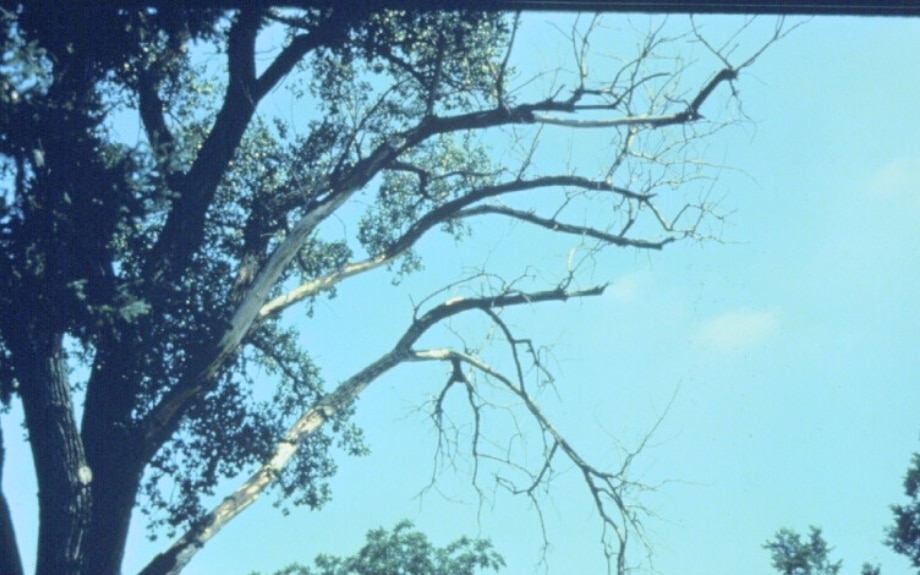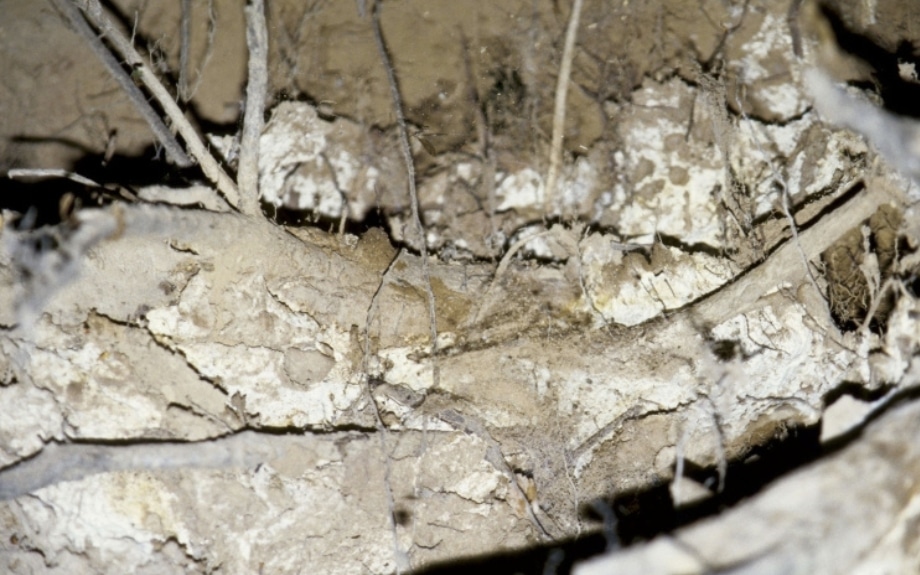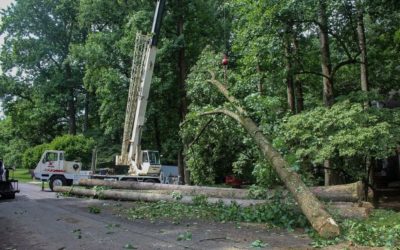Blog Topics
A tree’s roots are its lifeline to water, oxygen, and nutrients; when those lifelines are cut or damaged, the tree will struggle to survive. Saving a tree with damaged roots is a long process that requires a homeowner to nurse the tree back to health with a few tried-and-true methods. Even with proper maintenance, there is no guarantee you can save a tree.
In this article, we will examine how tree roots become damaged, what a tree’s chances of survival are after they’ve sustained root damage, and how you can help a tree recover from damaged roots.
Key Takeaways
- Typical symptoms of a tree with damaged or severed roots include leaf wilting, dead buds, and discolored leaves.
- Roots may sustain damage from construction involving heavy equipment traffic and trenching or attacks from insects and diseases.
- A tree with damage to less than ¼ of its roots may survive, as a general rule of thumb.
- Maintaining a tree with damaged roots includes aerating the soil, pruning out deadwood, providing supplemental water as needed, mulching around a tree, and supporting leaning trees.
- Some trees with damaged roots require removal if they become a hazard to a property and the people on it.
PRO TIP: These symptoms do not always point to root damage and may indicate something else affecting your tree. Consult an arborist for a more thorough diagnosis of what is wrong with your trees.

Deadwood is a common sign of damaged roots in a tree. Photo courtesy of Joseph OBrien, USDA Forest Service, Bugwood.org.
Symptoms of a Tree with Damaged Roots
Since roots are underground, it isn’t always apparent that something is amiss with them. To identify the symptoms of damaged or severed roots, you’ll want to look elsewhere for the typical signs, such as:
- Wilting Leaves: When a tree has wilting leaves, it signals that something is wrong, possibly due to root damage. If the damage affects roots on a specific part of the tree, you may notice wilting primarily on that side. Coniferous trees are an exception and might not show wilting as distinctly. Over time, these symptoms will worsen if the underlying issue isn’t addressed.
- Dead buds: Damaged roots can lead to a tree’s buds and twigs immediately dying, stressing the tree. Over time, you may notice dead sections on your tree, sparse leaves, and general branch dieback.
- Discolored leaves: Trees with severed roots may have leaves that appear brown, scorched, or demonstrate early fall colors.
How Tree Roots Become Damaged
Broadly speaking, tree roots take damage from two major factors: human-caused damage and environmental damage. It’s easier to damage roots than you might think, as about 50 percent of a tree’s root system is in the top foot of soil, and 90 percent of the root system is in the top three feet.
Construction Near Trees Can Damage Roots
Construction can often have disastrous consequences for any trees in the vicinity. In a battle between delicate roots and heavy machinery, the machinery will win every time.
Construction damage to trees tends to come in two primary ways:
- Trenching and digging: Tree roots spread far – much farther than the average person thinks. When a construction crew digs a trench, they may sever or expose a tree’s roots without knowing it.
- Soil compaction: Construction equipment is heavy, and construction crews often do plenty of walking around a job site. This traffic can compact soil, crush roots, and leave a tree unable to secure oxygen and water from the roots.
Environmental Factors
Tree roots can also end up damaged from attacks by insects or tree diseases. Issues like root rot and fungal infections can kill roots. It’s more difficult to detect these root problems, as they happen underground and out of sight, compared to more obvious damage from construction.
Drought conditions can also damage roots (we experience droughts somewhat frequently in the summer in Fairfax County), as well as excess water from storms.
Can you save a tree with damaged roots?
The answer will depend on the species and its health before the root damage. The general rule of thumb says most trees can survive root damage if the damage is less than ¼ of the total root zone.
Tips to Help Maintain a Tree with Damaged Roots
While severed, damaged, or paved-over roots are quite bad for a tree, they aren’t necessarily a death sentence. With a concerted effort, you may be able to save your tree with these techniques.

Compacted soil can lead to root rot, damaging roots and leaving them unable to provide oxygen and nutrients for a tree. Photo courtesy of Joseph OBrien, USDA Forest Service, Bugwood.org.
Aerate the Soil to Reduce Compaction
Compacted soil makes it difficult for roots to grow and take up water, oxygen, and nutrients. When a stressed tree is trying to rebuild its root system, compacted soil makes the job even harder. An arborist can use an air spade or drill small holes to aerate the soil without harming the roots. Breaking up the soil will reduce compaction and allow it to regain its pores, where it stores water and where roots can grow.
Give Trees Supplemental Water as Needed
A tree’s roots bring up water through the process of transpiration. When the roots are cut or damaged and can’t fulfill the task, the tree will end up stressed from a lack of necessary water. Providing supplemental water can help a tree recover.
We recommend using a hose with a soaker attachment to water your trees. The goal is deep soaking to refill the soil’s reservoirs rather than just dampening the top portion of the soil. You can also use a slow-release watering bag to water your trees.
Before you water your trees, ensure they need supplemental water by inserting a probe into the soil (we recommend a screwdriver since you’ll likely have one lying around). If the screwdriver comes out dry, you should provide water to the tree.
Provide water to the entire area inside a tree’s drip line (the area underneath a tree’s canopy), and avoid wetting the root collar (the portion of the tree where it enters the ground).
WARNING: While we recommend providing supplemental water, overwatering your trees can do more harm than good. As a guideline, you’ll want to leave the soil damp, not soggy. There should be no runoff water.
Apply Mulch Over the Root Area
Mulch simulates the forest floor and is beneficial for any trees. But these benefits are even more profound for a tree with severed roots.
Mulch benefits trees by moderating soil temperatures, helping to maintain moisture, conditioning the soil, and reducing competition from weeds and grass.
Choose an organic mulch of wood chips or shredded bark. The mulch should extend to at least the drip line and be between two and four inches thick.
Vertical Mulching Can Improve Soil Structure
Vertical mulching is another method arborists use to reduce soil compaction and improve soil structure. Vertical mulching involves using an augur to create small holes developing out from a tree trunk. The holes should be at least 18-inches deep and should go out to the tree’s drip line.
Once you have your holes drilled, we recommend backfilling them with something that will decompose like mulch or compost. Once the material decomposes, it will improve the soil structure and encourage root growth.
Provide Support to a Leaning Tree
Roots aren’t just for providing nutrients to a tree; they also anchor it to the ground. A tree with damaged roots may begin to lean and threaten your family and property. Staking a tree can help correct the leaning problem and keep it upright while it regrows its roots.
WARNING: Leaning trees can be dangerous, and removal may be the best action to avoid an uprooted tree.

Prune Out Deadwood From Your Tree
A tree with damaged roots will likely develop dead sections on the canopy and deadwood, as it can’t get enough nutrients and oxygen to support the growth it used to have. When you notice these dead sections, it’s time to prune them out aggressively, as they can break off during a storm and lead to injuries or property damage.
While we usually advocate for spring and winter being the best time for pruning, there’s no bad opportunity to remove deadwood, as long as you prune properly.
Riverbend Can Help Your Trees With Damaged Roots
When a tree’s roots end up damaged, severed, or paved over, it can be hard for them to recover. Some trees won’t survive the experience, and others that do will struggle to thrive. Some techniques to try and nurse your tree back to health include providing supplemental water, aerating the soil, and mulching around a tree’s root area.
At Riverbend, we have the tools and experience to do whatever is possible to save your tree. Or, if a tree’s root damage is too severe, we can safely remove the tree and allow you to open up space for a new one. Call us today at 703-402-9366 or request an estimate online to get help with your trees.
Give Us a Call at 703-402-9366
If you'd like help with your trees or landscape, have any questions, or would like to schedule an appointment with one of our Certified Arborists, please give us a call. We'd love to hear from you!



